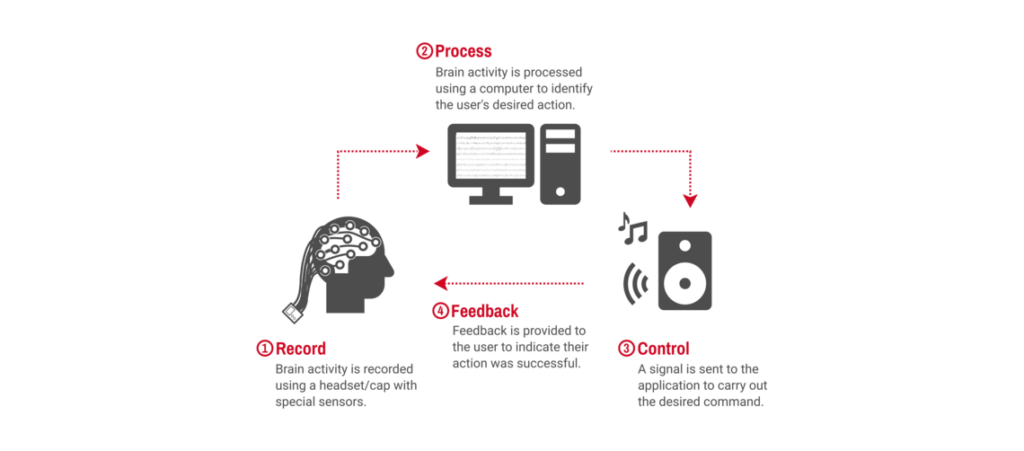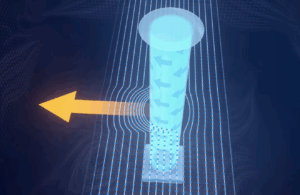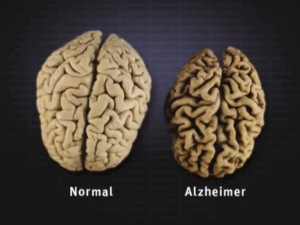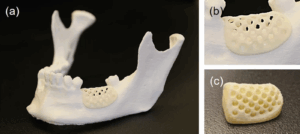What are Brain-Computer Interfaces (BCIs), and how are they revolutionizing the way the human body functions with technology?
The possibility of controlling one’s surroundings with thoughts had only existed in science fiction until now. With today’s advancing technology, a new reality has emerged. People can now interact, modify, and control their surroundings through electrical signals derived from brain activity (1). With the development of brain-computer interface (BCI) technology, people with certain disabilities could regain full function of their limbs, a feat previously considered impossible.

EEG external device (left) worn on the scalp to detect brain activity on the surface compared to implanted device (right) directly detecting brain signals
BCIs can potentially help people affected by neuromuscular disorders, such as cerebral palsy, stroke, spinal cord injuries, or even amputees (1). They allow an individual to use brain signals to control an external device with a computer-based system (1). For example, people with paralysis could translate their thoughts into words on a screen, or amputees could wear BCI-controlled prosthetic limbs that they can control with their minds (2). BCIs work through implanted or worn devices that take signals directly from the brain or brain activity encountered on the scalp (2). These signals are then processed by a computer system and converted into orders for devices like prosthetics or computer screens (1).
BCIs don’t function completely on their own, however. User input and a generated output are necessary for their use. For example, electroencephalogram (EEG) machines that measure activity in the brain (Figure 1) can record brain signals but don’t create a verbal or physical command for an external device (1,3). Brain-computer interfaces work with EEGs to allow users to carry out actions by interpreting meaningful brain signals, not by automatically reading people’s minds to extract information. The users eventually need to learn ways to intentionally create brain signals with specific messages. Over time, the BCI learns how to accurately decipher these signals and effectively translate them into commands (1).

While this technology opens up doors for many people, it is impossible to ignore BCIs faults and ethical implications. For this technology to be readily functional, BCIs need to be portable and adaptable. While wireless EEGs and other methods for efficiency are being tested, they remain experimental and not very widespread (2). In addition to functionality, cost is a huge concern. The cost of portable BCI technology is thousands of dollars, making it highly inaccessible and unavailable to the people who could benefit the most (1). Additionally, in invasive surgeries like brain implants, there is a major risk of injury or brain damage which can cause issues like infection, scarring, and harm to neuron production (4).Despite this technology’s flaws, with further research, innovation, and ethical supervision, BCIs have the power to transform lives, empower individuals with disabilities, and redefine the boundaries of human capability.
Bibliography:
- Shih, J. J., Krusienski, D. J., & Wolpaw, J. R. (2012). Brain-Computer Interfaces in Medicine. Mayo Clinic Proceedings, 268–279. Retrieved from https://doi.org/10.1016/j.mayocp.2011.12.008.
- Office, A. (2022). Science & Tech Spotlight: Brain-Computer Interfaces. Gao.gov Retrieved from https://www.gao.gov/products/gao-22-106118.
- (2022) EEG (electroencephalogram). Mayo Clinic. Retrieved from https://www.mayoclinic.org/tests-procedures/eeg/about/pac-20393875
- Miller, A. (2022, July 21). Exploring the Ethical Challenges of Brain–Computer Interface Technology. Neuroscience from Technology Networks. Retrieved from https://www.technologynetworks.com/neuroscience/blog/exploring-the-ethical-challenges-of-brain-computer-interface-technology-363367#:~:text=Injury%2C%20stigma%20and%20obsolescence%20%E2%80%93%20the,inhibit%20the%20regeneration%20of%20neurons.
Images:















Comments are closed.